Abstract
When writing this essay, the masterʼs work is not yet completed. Final completion: June 2021. The full text of the work and materials on the topic can be obtained from the author or his leader after the specified date.
Content
- Introduction
- 1. Relevance of the topic
- 2. Principle of operation of systems with spectral compaction
- 3. Purpose and objectives of the study, planned result
- 3.1 Analyze and increase the bandwidth of WDM technology in urban networks
- 3.2 Providing an additional E1 stream to the client
- Conclusions
- List of references used
Introduction
Recently, a significant reduction in the cost of optical channels has been achieved due to multiplexing with wavelength division. Wave division Multiplexing (WDM) is a transmission technology in optical systems where different sources use different wavelengths. In this case, two or more optical signals are combined and transmitted along one common optical path. This technology allows combining the transmission of multiple data streams over a single physical fiber–optic cable. This increase in cable capacity is achieved based on a fundamental principle of physics. It consists in the fact that light rays with different wavelengths do not interact with each other. The basic idea of WDM systems is to use multiple wavelengths (or frequencies) to transmit a separate data stream on each of them.
1. Relevance of the topic
The growth in the volume of transmitted data gradually led to the exhaustion of the bandwidth of the existing optical fiber, with all the urgency raising the question of its increase. Traditional telecommunications technologies allow only one signal to be transmitted over a single optical fiber. The essence of the technology of spectral or optical compaction is the possibility of organizing many separate signals on a single fiber, and, consequently, a multiple increase in the bandwidth of the communication line. WDM technology allows you to significantly increase the bandwidth of the channel, and it allows you to use already laid fiber–optic lines. Thanks to WDM, it is possible to organize two–way multi–channel traffic transmission over a single fiber (in conventional lines, a pair of fibers is used – for transmission in the forward and reverse directions).
2. Principle of operation of systems with spectral compaction
Each laser transmitter generates a signal at a specific frequency from the frequency plan. The optical fiber has three transparency Windows in the infrared region; their Central wavelengths are 850, 1300 and 1550 nm. For long-distance transmission, only the 1300 and 1550 nm bands are used, which are characterized by minimal signal attenuation. That is, more than a hundred standard channels can be transmitted over a single fiber.

Figure 1–the Principle of signal transmission in WDM (animation: 36 frames, 5 cycles, size 9 KB)
The WDM circuit diagram is quite simple. In order to organize several optical channels in one fiber, SDH signals are "colored", that is, they change the optical wavelength for each such signal. The colored signals are mixed using a multiplexer and transmitted to the optical line. At the end point, the reverse operation occurs – colored SDH signals are isolated from the group signal and transmitted to the consumer. The figure shows how multichannel transmission is carried out over fiber. A wave multiplexer combines signals with different carriers from several input fibers and transmits them over a single backbone fiber. Multiplexing is performed by passive devices, the functioning of which is based on known phenomena of physical optics – dispersion, diffraction, interference. The reverse operation is implemented by a wave demultiplexer: it separates single-channel streams from multi–channel traffic and directs them to separate fibers. When performing these operations, quite common today broadband fiber amplifiers with erbium additives are used, each of which simultaneously serves all fiber channels. In such amplifiers, the radiation of the pump laser is absorbed by the atoms of the impurity (erbium) introduced into the fiber, and then the energy stored in them is displayed as an optical signal. Most often, optical amplifiers are located tens of kilometers from each other; some WDM systems make it possible to bring this distance to 120 km.
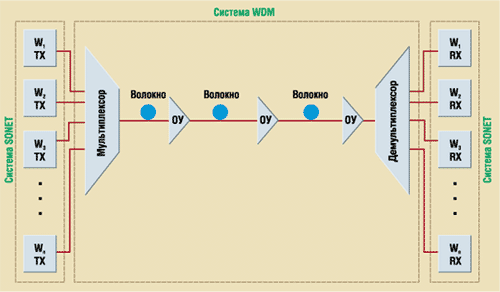
Figure 2 – Multichannel fiber transmission (TX & ndash; transmitter, RX – receiver, OP AMP – linear optical amplifier)
3. The purpose and objectives of the study, the planned result
The purpose of this work is: the goal is to increase the capacity of fiber-optic trunks through the use of wavelength division multiplexing technology.
Tasks:
- Analyze and increase the bandwidth of WDM technology in urban networks.
- Providing an additional E1 stream to the client.
3.1 Analyze and increase the bandwidth of WDM technology in urban networks
The use of WDM technology at the city network level gives providers significant flexibility that allows them to offer services for different market sectors. Optical transmission transparency allows local communication over existing protocols (IP, Ethernet, etc.) with added protection at the SONET/SDH line level. This is not to say that urban-scale DWDM systems are necessarily simpler than their counterparts on high-length lines. For local communication networks, flexibility is much more important. When designing them, it is necessary to provide for as many possible configurations as possible, with as little dependence as possible on the transmission protocols used. Installing an urban-scale WDM system does not necessarily mean abandoning existing SONET/SDH networks: they can exist in parallel, and certain parts of DWDM systems can transmit SONET/SDH traffic. Moreover, to effectively use the bandwidth of WDM systems, SONET/SDH, IP or ATM traffic in the original format can be transmitted over various channels. Urban-scale WDM systems also allow the transmission of traffic from protocols such as Gigabit Ethernet, FDDI, and ESCON. Although it is not always economical to transmit "time-inefficient" Gigabit Ethernet signals in their original format over high-length WDM channels, it sometimes makes sense to do so for short distances typical of urban communication networks. Trunk lines usually have a length of more than 50 km, and they are typical of the optical and technical limitations of systems of this length. At the same time, the requirements for their flexibility remain high. For example, they can be used by providers to provide high-quality communication services. Although linear optical amplifiers are often required for lines of this length, they can be quite economical when operating at low transmission speeds, which reduces the cost of such systems. Urban DWDM systems often have a ring topology (either as two rings with opposite transmission directions, or as a single bidirectional ring) that is compatible with the ring topology of SDH networks. Monitoring and protection schemes provide fast switching of channels to the reserve (in the order of tens of milliseconds) in case of failure of any component or fiber.
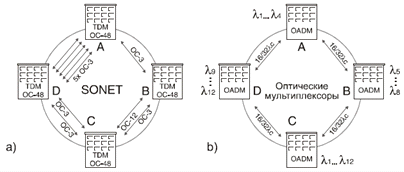
Figure 3 – Urban networks
а) The TDM ring is overloaded between nodes A and D б) A rational decision – ring WDM
In a DWDM ring network, channels are added and allocated at arbitrary points in the ring, so channel balancing can be difficult, although due to the lack of EDFA amplifiers, it becomes much less significant. The ring topology of the network itself can also lead to certain problems. For example, for the delivery of cable TV services to apartments, networks of the "tree" type topology are best suited. Fortunately, for DWDM ring networks, methods have been developed for organizing various network topologies (tree
, point-to–point
, broadcasting, etc.) due to the appropriate use of a large number of available channels in the ring.
The urban WDM network (figure 3b) is more cost-effective than traditional SONET/SDH lines (figure 3A). The complexity of the equipment for adding / allocating channels in DWDM networks depends only on the characteristics of this channel, it does not have to work with the entire information band of the communication line. In addition, the transition of the communication line to WDM technology and the addition of new services does not disrupt the transmission of existing traffic, which is especially important when the services provided are constantly changing.
The transmission of signals in WDM networks is not limited to certain time frames or protocols, the choice of which was previously often determined by the capabilities of the transmission systems used in the network, and not by the convenience for users. The WDM network can simultaneously transmit data in a wide variety of formats, including essentially analog voice and video streams, at a wide range of speeds. User-friendly protocols - for example, Ethernet can be passed transparently, without any signal transformation, and the network itself does not need to take into account the requirements of a specific transport Protocol.
In addition to all these advantages, urban WDM networks are often very easy to connect to backbone networks with the same transmission speeds and protocols. Components and systems for urban WDM networks have recently become available: the price of a two-fiber inter-office communication line is from 30 to 50 thousand US dollars per channel, the cost of urban access networks is even lower.
Along with offering new services, the transition to WDM systems should provide the customer with all the redundancy mechanisms that are provided in SONET/SDH networks. This requires careful, comprehensive network planning, with price, functionality, and the ability to expand the network in the future being key factors.
3.2 Providing an additional E1 stream to the client
Consider a network that combines three client nodes with a Central node. All clients are provided with an SDH stream of the STM level 1. for this purpose, the SDH ring of the STM level 1 is used, which is created by sequentially combining the Central and subscriber nodes with fiber pairs (figure 4). let's also Assume that the STM-1 network is fully loaded, and the customer served by node B has requested an additional 10 E1 streams. Assume that there are additional fibers everywhere, except for the area between the Central node and node C (Fig. 4)
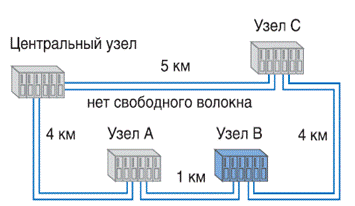
Figure 4 – Structure of a typical network for servicing three clients with a STM-1 stream by one Central node
•The Telecom operator can solve the problem of providing the client node В
requested resources using WDM.
You need to create a second SDH ring that uses the sections from the Central node to the node А and between nodes А–В and В–С available free fibers, and on the section from the Central node to the subscriber node With WDM spectral compaction equipment and two channels at different wavelengths. There are several ways to implement a WDM system on the section from the Central node to the C node. For example, consider two options. Option A. the first SDH ring of the STM-1 level initially operated at a wavelength of 1310 nm, and therefore it is advisable to leave it unchanged if possible. The additional STM ring 1 on the section from the Central node to the subscriber node C will operate at a wavelength of 1550 nm, and on the remaining sections at a wavelength of 1310 nm using a free pair of fibers. Therefore, it is necessary to install wavelength converters in node C. In addition, multiplexers that combine the two wavelengths must be installed in the Central node and subscriber node C. (figure 5).
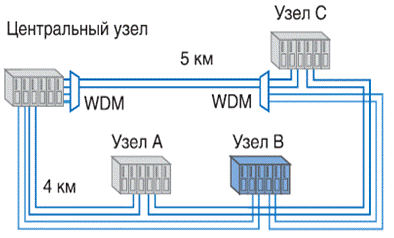
Figure 5 – Network structure for serving three clients with two E1 streams using WDM
Prices for WDM equipment are taken from a domestic manufacturer. The WDM kit includes multiple transponders and multiplexer / demultiplexer kits.
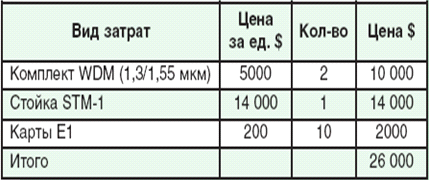
Figure 6 – Summary table of costs when using WDM
4. Conclusions
During the master's thesis, the optimal variant of traffic compaction in WDM networks, in the considered urban-type network, was proposed. The latter follows from the analysis of the typical situation of lack of bandwidth of fiber-optic highways that arise in urban telephone operators.Based on this analysis, it is concluded that with an uncertain growth in traffic, the use of WDM technology allows the provider to flexibly respond to the growth of customer needs, without the risk of investing assets in fibers that may not work for a long time. In addition, according to the analysis, WDM technology is most effective where urgency is required and it is necessary to avoid long-term construction of a new fiber optic network.
References
- Оптические линии связи // Новосибирск: Сибирский государственный университет телекоммуникаций и информатики.– 2003.– (Рус).
- Скляров О. К. Современные волоконно–оптические системы передачи, аппаратура и элементы. – М Солон – Р, 2001.– 240c.
- Основы оптоэлектроники / Суэмацу Я., Катаока С., Кисино К. и др. Пер. с яп. – М.: Мир, 1998. – 288 с., ил.
- Заславский К. Е. Волоконная оптика в системах связи и коммутации. Новосибирск, 1999. – 124 с.
- Иванов А. Б. Волоконная оптика: компоненты, системы передачи, измерения. – М.: Компания САЙРУС СИСТЕМС, 1999. – 672с.
- Семенов А. С. Интегральная оптика для систем передачи и обработки информации / А. С. Семенов, В. Л. Смирнов, А. В. Шмалько - М.: Радио и связь, 1990. – 224 с.
- Убайдуллаев Р. Р. Волоконно-оптические сети. – М.: Эко-Трендз, 1998. – 270 с.
- Андре Жирар. Руководство по технологии и тестированию систем WDM. Пер. англ. под ред. А. М. Бродниковского , Р. Р. Убайдуллаева , А. В. Шмалько. М. : EXFO , 2001 .
- Гладышевский М.А. Волоконно-оптическая связь: Экономические перспективы использования WDM-технологии // Lightwave Russian Edition. 2004 , № 2 , С. 14 – 19 .
